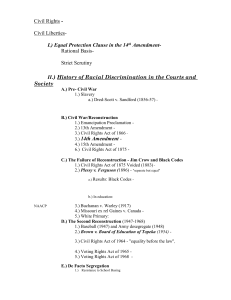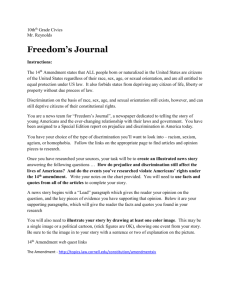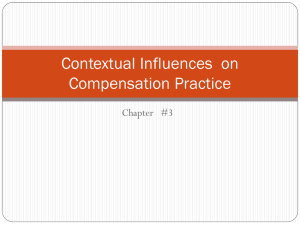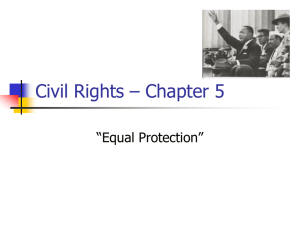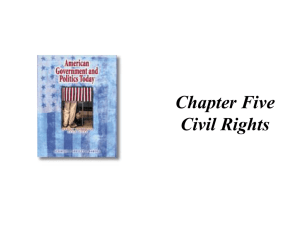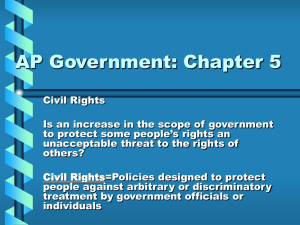Civil Rights
advertisement
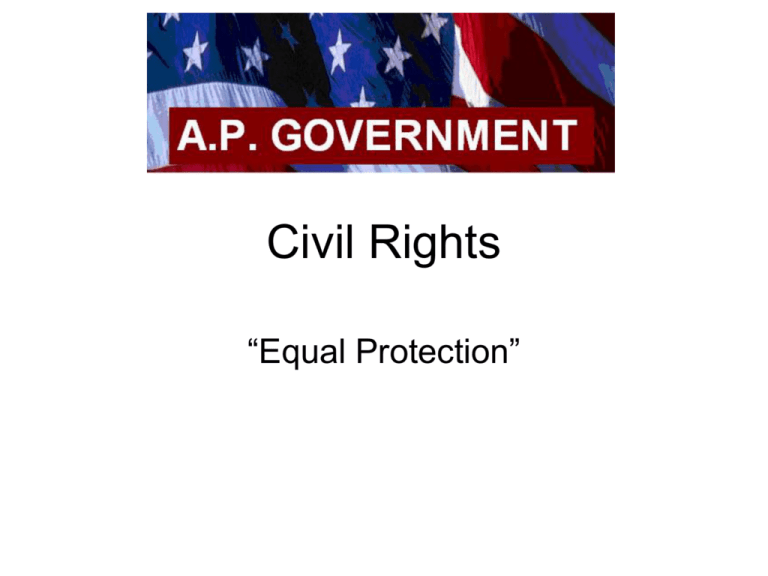
Civil Rights “Equal Protection” 14th Amendment (1868) • Forbids any state to “deny to any person within its jurisdiction the equal protection of the laws.” • Originally designed to protect newly freed African Americans from infringement of their rights by state governments • Has been expanded to cover Suspect Categories such as gender, race, ethnicity, age, disability, or sexual orientation Supreme Court Guidelines • Reasonable Classification – The court has ruled that government must have the power to make reasonable classifications between persons and groups – reasonable classifications include denying suffrage to those under age 18 or imposing a high excise tax on cigarettes which smokers must pay Supreme Court Guidelines • Intermediate Scrutiny – If the policy “serves an important government interest” and is “substantially related” to serving that interest, it is constitutional – Ex: Men can be punished for statutory rape even if women are not punished because men and women are not “similarly situated” – Ex: Men can be barred from hospital delivery rooms even though women are admitted (Duh!!) Supreme Court Guidelines • Strict Scrutiny – The Supreme Court has ruled that classification by race and ethnic background is inherently suspect and must therefore meet a strict scrutiny test – classification based on race and ethnic background must be justified by a “compelling public interest” – Ex: you cannot bar a specific racial group from a public school or from voting, nor can you bar a specific religious group from knocking on your door to promote its views Historical Cases • • • • Dred Scott (1857) Blacks aren’t citizens 13th Amendment (1865) Abolished slavery 15th Amendment (1870) suffrage for black males Jim Crow Laws – segregated community • de jure (by law) and de facto (by reality) • Plessy v. Ferguson (1896) separate but equal • Brown v. Board of Education – “separate but equal” unconstitutional Civil Rights Act of 1964 • Ended Jim Crowe segregation in public accommodations (hotels, restaurants) – Made racial discrimination illegal – used the Commerce Clause • Schools Desegregated – Gov can force desegregation though litigation • Equal Employment Opportunity – Prohibited discrimination in employment based on race, color, national origin, religion, or gender Disenfranchisement • Poll Taxes – required voters to pay a tax to vote (eliminated by the 24th Amendment in 1964) • Literacy Tests – I could never vote • White Primaries – excluded African Americans from participating • The Grandfather Clause allowed most whites to avoid these obstacles Voting Rights Act of 1965 • Outlawed literacy tests • Provided federal oversight of voter registration in areas with a history of discriminatory practices • Reduced voter registration disparity between African Americans and whites – This led to a steady rise in the number of African Americans who were elected to public office. In 1965 70 African Americans held public office in 11 southern states, today the number is over 5,000 Native Americans • Almost half of the 2 million Native Americans live on “reservations” • Push for more sovereignty on their land with less governmental regulation – Ex. – gambling operation rights • Art. 1, Sec. 8 – commerce clause give Congress right to regulate Indian tribes Latino/Latina Rights • 53 million in US (2012) (about 10 million in 1980) • Mexican –)-rights issues include Bilingual education programs, immigration • Puerto Rico is a commonwealth of US, citizens can move freely back and forth, not represented in Congress, don’t have to pay federal tax • Cuban population tends to be conservative Asian Americans • 14.7 million in US • Chinese Exclusion Act 1882 – lasted through WWII • WWII – Japanese racism – internment • Korematsu v. US (1944) • 1980s reparations for internment • Current trend is immigration from Vietnam, Cambodia, and Laos Asian Americans • Gen. John L. DeWitt, who administered the internment program, repeatedly told newspapers that "A Jap's a Jap" and testified to Congress: “I don't want any of them [persons of Japanese ancestry] here. They are a dangerous element. There is no way to determine their loyalty... It makes no difference whether he is an American citizen, he is still a Japanese. American citizenship does not necessarily determine loyalty... But we must worry about the Japanese all the time until he is wiped off the map.” Women and Equal Rights • Seneca Falls Convention – 1848 – beginning of women’s suffrage movement • Muller v. Oregon (1908) – upheld 10 hour work day limit for women • 19th Amendment (1920) Women can vote! • 1970s – “reasonableness standard” – all legal circumstance must be treated equal – Ex. Cannot set different age limits for driving, but can set laws on rape that punish man only Women and Equal Rights • Equal Rights Amendment (ERA) 1972 – “Equality of rights under the law shall not be denied or abridged by the US or any State on account of sex.” – did not pass because… • Rostker v. Goldberg (1981) – Court upheld the requirement men to register but not women for draft, ended ERA push • Roe v. Wade (1973) – women’s freedom to choose abortion Women and Equal Rights • Civil Rights Act (1964) • Title VII – prohibits gender discrimination in employment, extended to sexual harassment • Comparable worth – “equal pay for equal work” • Title IX – provide equal funding for all programs that receive federal funding Rights for Older Americans • Age discrimination illegal • Age Discrimination in Employment Act raised the general compulsory retirement age to 70 • AARP – interest group – large influence Rights for Disabled Americans • 17% of Americans have a disability • Rehabilitation Act of 1973 - illegal to discriminate based on disability • Education for All Handicapped Children Act of 1975 – gave all handicapped children free education • Americans with Disabilities Act of 1990 – protect disabled rights – SC has somewhat limited this act Homosexual Rights • 1993 – “Don’t Ask, Don’t Tell” – gay rights to be in the military (overturned 2011) • Hardwick v. Georgia (1986) – a law forbidding homosexuality was constitutional • Lawrence v. Texas (2003) – law against homosexual action violated due process of 14th Amendment – “life, liberty, and property” (overturned Hardwick) Affirmative Action • Affirmative Action is a policy requiring federal agencies, universities, and most employers to take steps to remedy the effects of past discrimination – Supporters believe we need to atone for past injustices – Critics believe that this creates reverse discrimination and punishes members of majority groups Reverse Discrimination • Equality of Opportunity vs. Equality of Results – Do civil rights require the absence of discrimination OR require racial balance? • University of California v. Bakke 1978 – strict quotas unconstitutional, race can be a criteria for admission to a public institution • Richmond v. Croson 1989 – city of Richmond could not guarantee that 30% of companies that received subcontracts were owned by minorities Civil Rights summary • Constant pursuit of equality • Civil Rights for minority groups will constantly be changing • EVERYONE will be a part of some minority group during their lifetime

